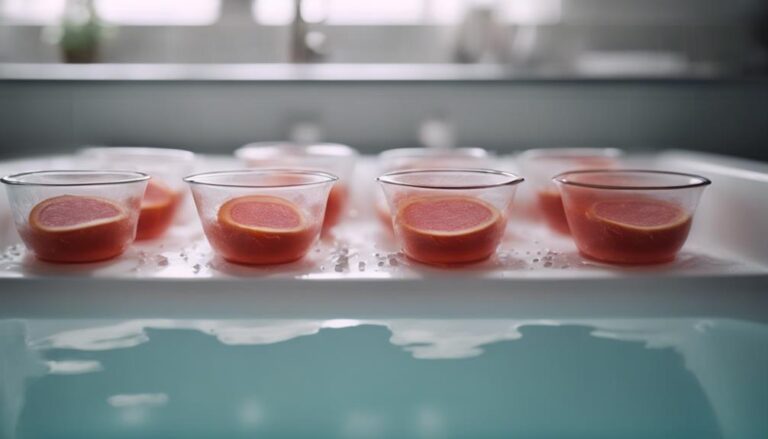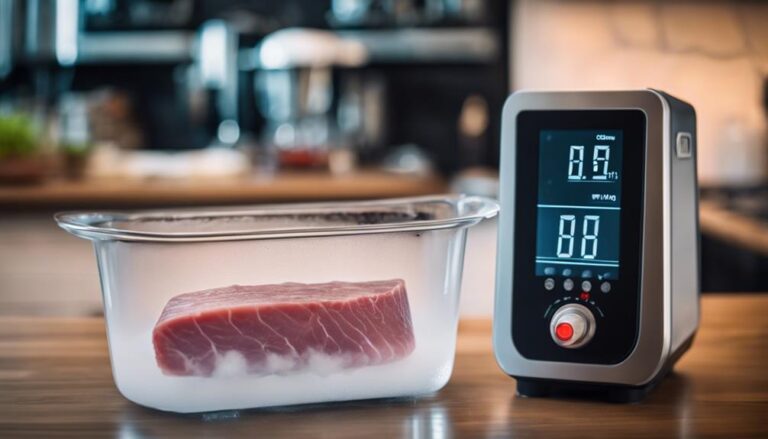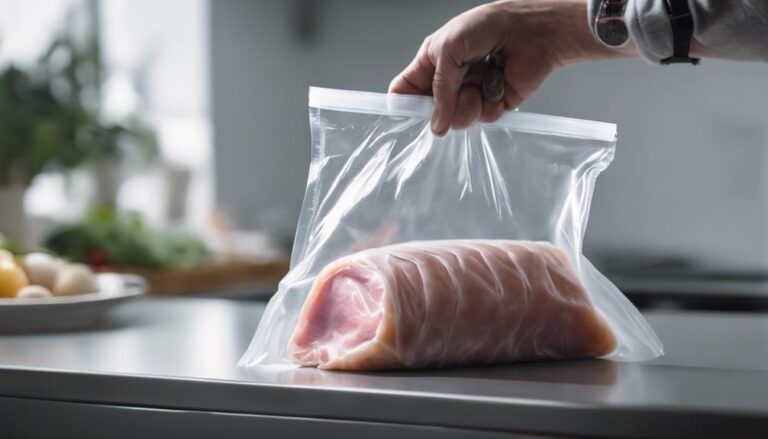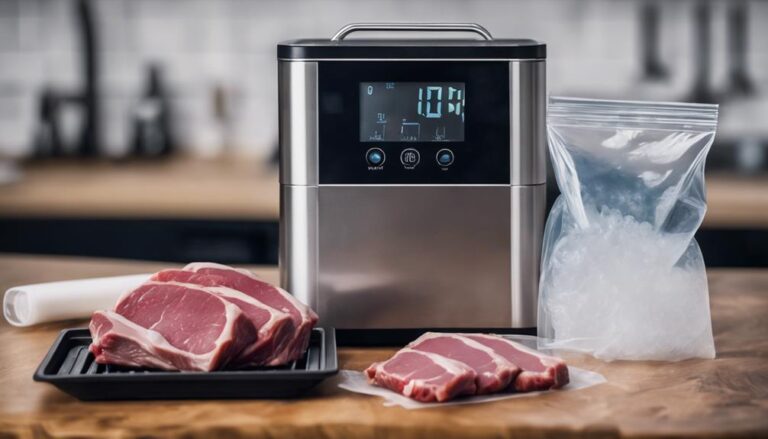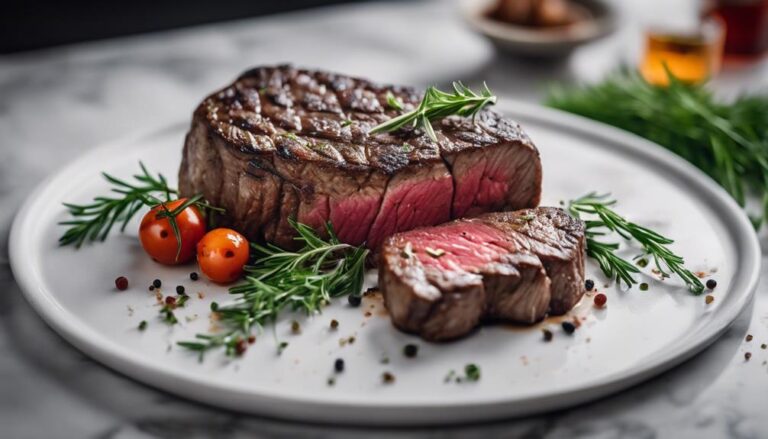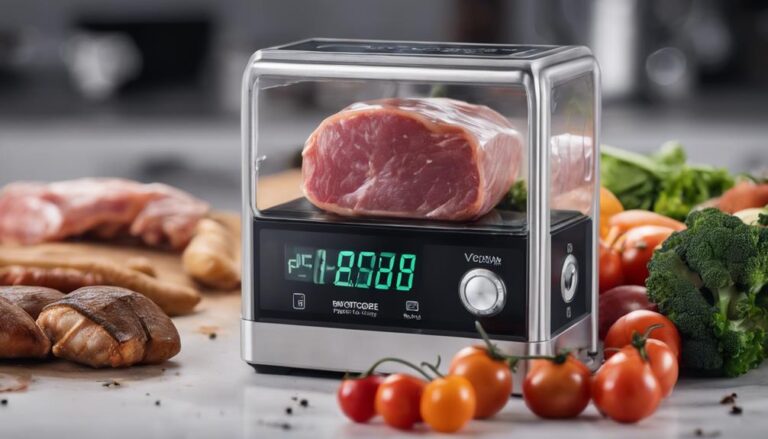Sous Vide Safety 101: Avoiding Common Mistakes
Hey, aspiring sous vide chef! To avoid blunders, nail precise temperature control. Watch that water temp like a hawk to zap bacteria and ace pasteurization. Got it? Vacuum seal like a pro to keep flavors locked and germs out. Stay chill – bacteria loves the 40F to 130F zone. Flash cool like a boss to keep those pathogens at bay. Store leftovers like a champ for freshness. Intrigued? Learn more about sous vide safety and impress with zero food safety slip-ups!
What You Will Learn Here
- Maintain accurate water bath temperature for pasteurization and food safety.
- Master vacuum sealing to preserve flavors, prevent bacterial growth, and ensure efficient heat transfer.
- Prevent bacterial growth by rapid chilling, proper storage, and precise temperature control.
- Utilize quick cooling methods to extend shelf life and maintain food quality.
- Store sous vide meals properly in labeled containers, chill leftovers below 40F, and thaw frozen dishes correctly.
Importance of Precise Temperature Control
To guarantee food safety and best results in sous vide cooking, accurate temperature control is absolutely essential. In the world of sous vide, it's not just about tossing food in a bag and hoping for the best – oh no! You need to be the temperature maestro, the conductor of the sous vide symphony.
Why, you ask? Well, my friend, precise temperatures are like the secret sauce that guarantees your food isn't only delicious but also safe to eat. Imagine this: you've got a juicy steak cooking in a water bath, and the only way to make sure it's perfectly pasteurized is by nailing that water bath temperature. Monitoring the temperature diligently is your ticket to sous vide success.
Proper Vacuum Sealing Techniques
For efficient heat transfer and to maintain food quality during sous vide cooking, mastering proper vacuum sealing techniques is essential. Vacuum sealing is like giving your food a tight hug, making sure there are no air pockets that could mess with the cooking process.
These sealed bags not only prevent water from sneaking in and ruining your meal but also keep bacteria at bay by kicking oxygen out. Say goodbye to bland dishes because vacuum sealing locks in all those delicious flavors, juices, and aromas, giving your taste buds a party to remember.
Using textured bags is like adding extra security to your cooking – think of it as double-locking your front door. These textured bags help create a solid seal, ensuring your food cooks perfectly and stays safe from any unwanted guests.
Preventing Bacterial Growth
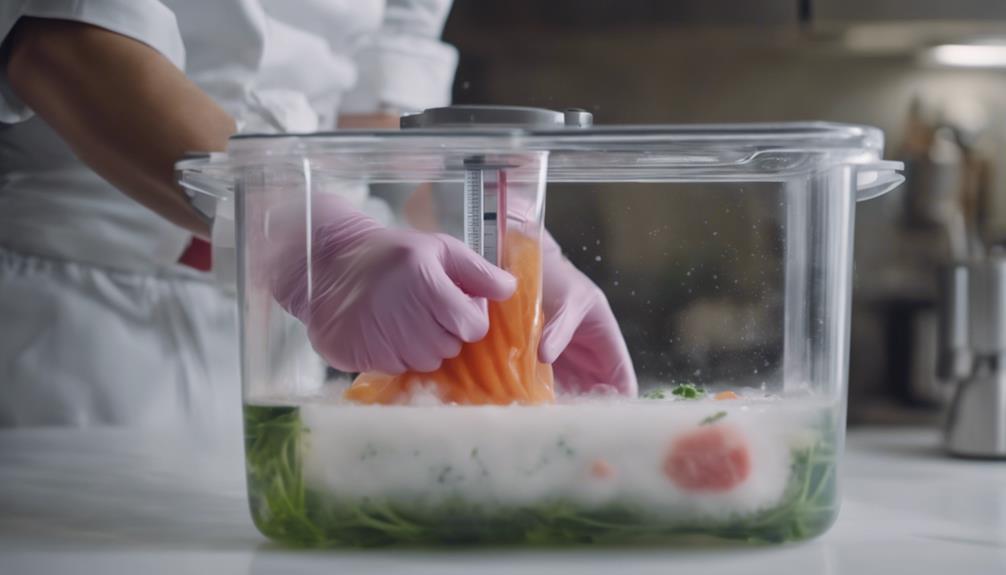
Hey there, ready to tackle bacterial growth in your sous vide adventures? Remember, bacteria love to party in that danger zone of 40F to 130F, so it's essential to keep things chill below 40F after cooking.
Precise temps and sealing your goods tight are your best pals in the battle against those pesky germs – sanitize your gear, stay cool, and cook on!
Proper Temperature Control
Maintaining a consistent water bath temperature above 130F is essential to prevent bacterial growth and guarantee food safety during sous vide cooking. Here are some key points to help you grasp the importance of proper temperature control:
- A steady temperature guarantees pasteurization, eliminating those pesky harmful pathogens.
- Cooking below 130F? Risky business! You mightn't be giving those bacteria the boot.
- Keep it hot! Proper temperature control keeps your food out of the danger zone, where bacteria throw a party.
- Following recommended ranges is like having a bodyguard against foodborne illnesses.
- Remember, precision is key in sous vide – your dinner shouldn't be a science experiment gone wrong!
Importance of Sealing
To guarantee top-notch food safety in sous vide cooking, concentrate on the efficient sealing of your ingredients to prevent bacterial growth. Vacuum sealing your food is like giving it a cozy little airtight blanket – no oxygen for bacteria to party and spoil your meal! By removing air from those sous vide bags, you're not only reducing contamination risks but also ensuring a safe cooking process. Pathogens won't stand a chance to multiply in that sealed environment. Remember, mastering sealing techniques isn't just about keeping your food fresh; it's about warding off those pesky foodborne illnesses. So, seal it tight, keep those pathogens at bay, and enjoy your sous vide creations without any unwanted surprises!
| Vacuum Sealing | Airtight Sealing | Safe Cooking Process |
|---|---|---|
| Prevents bacteria | Reduces contamination | Ensures safety |
| Removes air | Minimizes pathogens | Maintains food quality |
| Reduces risks | Prevents illnesses | Safe consumption |
Sanitizing Equipment Regularly
Regularly sanitize your sous vide equipment, including the immersion circulator, containers, and vacuum sealer, to prevent bacterial growth. Here are some tips to keep things squeaky clean:
- Use a food-safe sanitizer or a bleach and water solution for a germ-busting cleaning session.
- Remember, bacteria love moisture, so drying off your equipment is key to keeping the nasties away.
- Check nooks and crannies; those sneaky bacteria can hide in the most unexpected places.
- Set up a cleaning schedule; make it a routine so your gear is always ready for action.
- Don't let bacterial parties happen in your sous vide setup; show those critters the door with proper sanitizing!
Controlling Pathogens
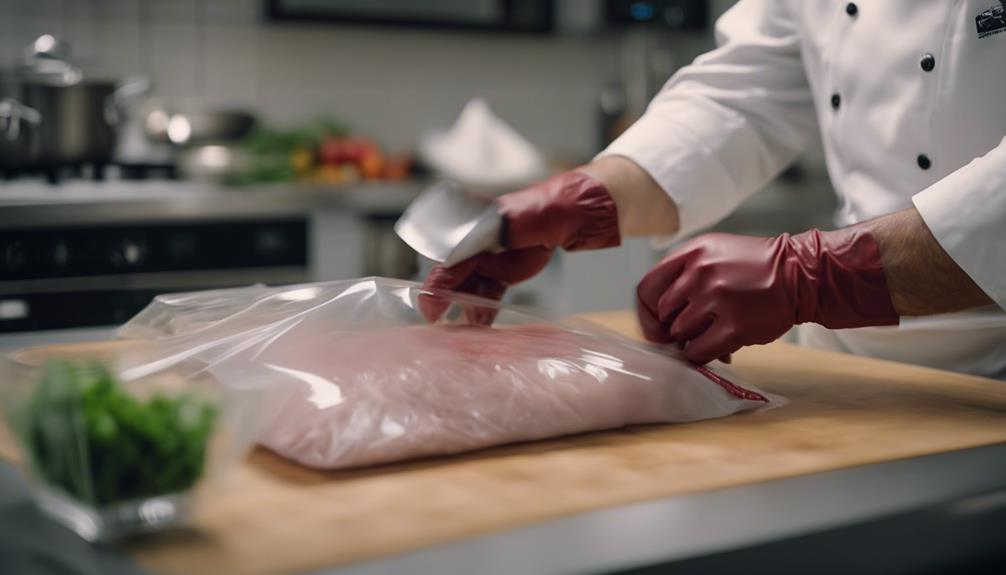
Controlling pathogens in sous vide cooking is crucial for ensuring food safety and preventing foodborne illnesses. Nobody wants a side of Salmonella or a sprinkle of E. coli with their dinner! To keep those pesky pathogens at bay, consider adding acidic components, salts, and spices to your sous vide recipes. These ingredients not only amp up the flavor but also help control those sneaky microorganisms. Remember, specific time and temperature combinations are like the secret codes to reducing harmful bacteria to safe levels in sous vide dishes. So, make sure you're hitting the right numbers to keep your food safe and delicious.
And hey, rapid chilling and proper storage temperatures are your best pals in this kitchen adventure. They work hard to prevent bacterial growth in your sous vide creations. Understanding pasteurization and sterilization might sound fancy, but they're just superhero processes that eliminate active food pathogens. So, embrace the chill and heat – your food will thank you!
Ensuring Proper Pasteurization
Effective pasteurization in sous vide cooking guarantees that harmful bacteria are thoroughly eliminated by heating food to specific temperatures. When it comes to ensuring proper pasteurization, remember these key points:
- Different proteins, like chicken and beef, require varying temperatures to kill bacteria effectively. It's like giving each protein its personalized spa treatment!
- Following recommended pasteurization times is essential. Think of it as cooking with precision, like a top chef working their magic.
- Proper pasteurization isn't just about tasty food; it's about keeping vulnerable individuals with compromised immune systems safe. Let's protect our loved ones!
- Understanding pasteurization guidelines for various foods is like having a secret recipe book for food safety. Knowledge is power!
- Preventing foodborne illnesses starts with proper pasteurization. It's like putting on a shield to protect your stomach from unwanted guests.
Quick Cooling Methods
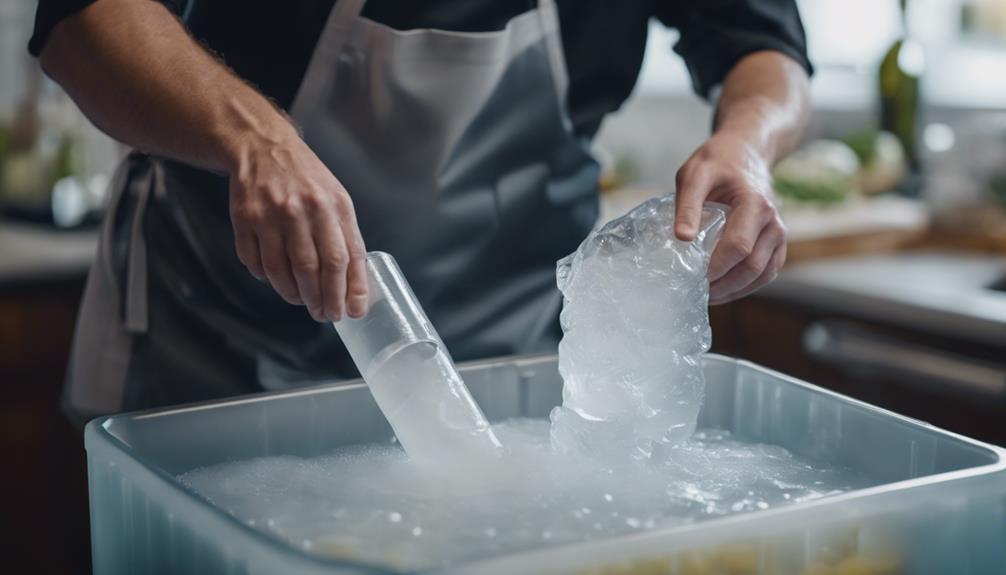
Hey there, so you've just finished cooking your sous vide meal to perfection, but now it's time to cool things down quickly. Quick cooling methods like the ice bath technique, freezer flash cooling, and rapid refrigeration are your best pals here.
These methods not only keep your food safe from bacteria but also help maintain that delicious taste you worked so hard to achieve.
Ice Bath Method
Ensuring food safety in sous vide cooking, the ice bath method swiftly cools your cooked items to prevent bacterial growth and maintain quality.
Here are some cool facts about using the ice bath method:
- Plunging your sous vide creations into an ice bath helps prevent contamination and guarantees your food is safe to devour.
- Rapid cooling in an ice bath keeps the texture and flavor of your dishes excellent, avoiding any unwanted mushiness.
- This cooling method is like giving your food a rejuvenating icy hug, preventing overcooking and preserving that perfect doneness.
- From proteins to veggies, the ice bath method works wonders for a variety of sous vide items, keeping them at their best.
- So, next time your sous vide masterpiece is done, give it a chill in an ice bath for food that's both safe and scrumptious!
Freezer Flash Cooling
To adequately execute freezer flash cooling for your sous vide dishes, promptly submerge the sealed bags in an ice water bath. This rapid chilling method is like throwing a frosty surprise party for your food, preventing unwanted bacteria from crashing the feast by quickly lowering those temperatures.
Remember, the ice water bath should be a cool 1:1 mix of ice to water – no lukewarm welcomes here! Quick cooling not only keeps your meals safe but also maintains their quality, giving them a longer shelf life.
Refrigeration Rapid Chill
After rapidly cooling your sous vide dishes in an ice water bath, another effective method for quick chilling is to transfer the sealed bags directly into a refrigerator to continue the essential chill process. This step is pivotal for maintaining food safety and preventing bacterial development.
Here are some key points to remember when using refrigeration for rapid chill:
- Refrigeration slows down bacterial growth, extending the shelf life of your sous vide creations.
- Quick cooling helps prevent spores from turning into pesky bacteria that could ruin your meal.
- Proper refrigeration is vital for food safety, so don't skip this step!
- By continuing the essential chill process in the fridge, you're ensuring your food stays fresh and delicious.
- Remember, a cool fridge is your best friend when it comes to sous vide cooking!
Proper Storage Practices
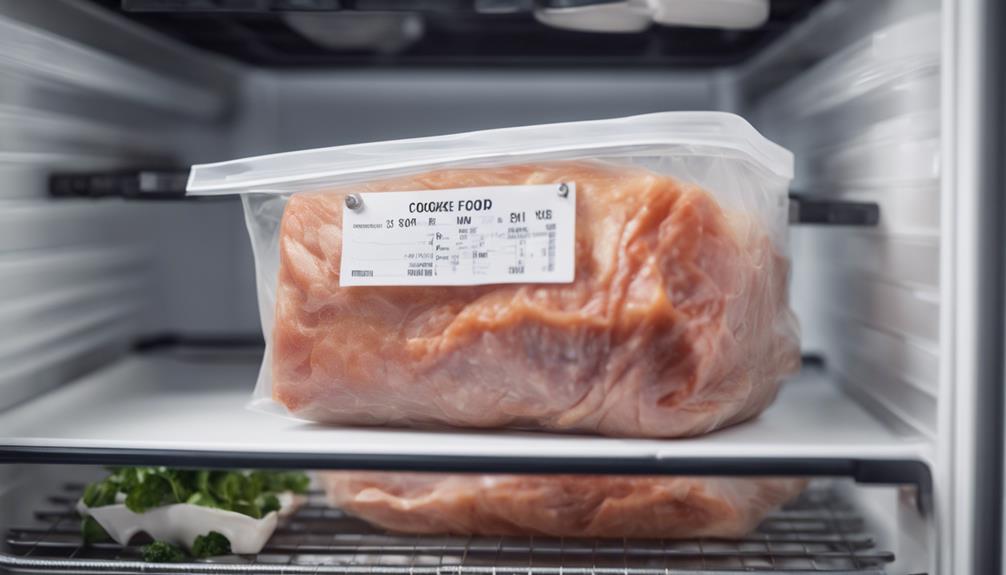
Store sous vide cooked food in airtight containers or vacuum-sealed bags to maintain freshness and prevent contamination. Don't let those delicious flavors escape! Be sure to label and date your stored sous vide creations. It's not just about keeping track of time; it's about ensuring you savor every bite at its peak.
When it's time to chill, pop those leftovers into the fridge pronto – below 40F (4.4C) is the magic number to keep bacteria at bay. Freezing your sous vide wonders? Use airtight bags or containers to avoid freezer burn. Remember, frozen meals have feelings too – keep them for up to 3 months for excellent taste.
Just don't forget to thaw them properly before reheating; you don't want icy surprises in your culinary adventures. So, whether it's storing, labeling, refrigerating, freezing, or thawing, treat your sous vide treats with the care they deserve!
Frequently Asked Questions
What Are the 6 Safety Steps for Sous Vide Cooking?
Maintain precise temperature control, guarantee food safety, adhere to recommended cooking times, submerge in water correctly, utilize proper vacuum sealing, upkeep equipment, inhibit bacterial growth, guarantee pasteurization, distribute heat evenly, and utilize sous vide bags for safe cooking.
What Is the Danger Zone for Sous Vide?
To guarantee food safety when using sous vide cooking, maintain precise temperature control. Avoid the danger zone, 40F to 130F, to prevent bacterial growth. Proper handling, time limits, and pasteurization processes are essential for safe cooking and minimizing pathogen risks.
What Is the Safety of Sous Vide Cooking?
Maintain precise temperature control to prevent food pathogens. Monitor cooking times diligently, ensuring water circulation and vacuum sealing. Guarantee proper heat distribution for pasteurization. Emphasize safe handling to inhibit bacterial growth. Implement effective cooling methods for safety.
Is It OK if Sous Vide Touches the Bottom?
It's not advised for sous vide bags to come into contact with the bottom. To guarantee uniform cooking, elevate bags using a rack. Avoid hot spots and ensure food safety by maintaining proper heat distribution. Your responsibility as a chef is to control temperature and prevent contamination risks.
Conclusion
So, remember folks, when it comes to sous vide cooking, precision is key! Make sure to seal your food properly, keep those bacteria at bay, and always double-check your temperatures.
And hey, don't forget to cool things down quickly and store leftovers like a pro. By following these simple steps, you'll be cooking up delicious sous vide dishes like a pro in no time.
Happy cooking!






